| アイコン | 意味 |
| 戦闘や事故で失った場合(沈没、墜落)や損傷した場合、艦船などの内部で事故や事件がおこった場合の意味です。自軍や同盟軍、所属機関、所有会社が行った沈没処分や破壊処分、漁礁としてまたは演習で使用して沈めた場合にはこのアイコンは付けません | |
| 戦果や功績、各機関に寄贈された場合の意味です。戦争などで沈没し、何十年後に発見された場合もこのアイコンです | |
| 映画やTVドラマ、ドキュメンタリーに使用された場合の意味です | |
| 参考文献、小説や書籍に登場する事柄です | |
| インターネットやTVゲームに登場する事柄です | |
| 不可解な事故&事件およびUFOなど超常現象に遭遇した事柄です |
- ※FYは会計年度 Fiscal Yearの略
- カーチス社製 初飛行:1944年2月16日(XSC-1) SC-1データ=全幅:12.50m 全長:11.09m 全高:3.89m 翼面積:26.01m² 空虚運用重量:2,867kg 最大離陸重量:4,080kg パワープラント:定格出力1,350hpのライト製R-1820-62サイクロン9星型ピストン・エンジン1基 最高速度(高度8,715m):504km/h 実用上昇限度:11,370m 航続距離:1,000km 兵装:機関銃:12.7mm機銃2挺 無誘導弾薬:組み合わせ容量295㎏の翼下爆弾架2台 乗員:1名
- ※社内呼称モデル97
- ※SCの追加ページ
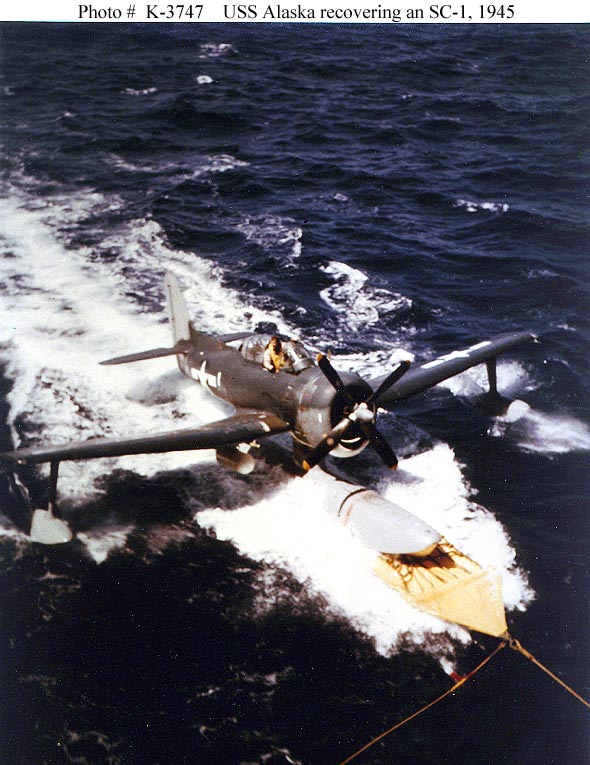

- マクドネル社(現ボーイング社)製 初飛行:1965年3月12日(RF-4B-20-MC) 退役日:1990年9月30日 RF-4Bデータ=全幅:11.707m 全長:19.177m 全高:5.004m 翼面積:49.239m² 空虚運用重量:14,152kg 最大離陸重量:24,857kg パワープラント:アフターバーナー使用時定格推力7,711㎏のジェネラル・エレクトリック製J79-GE-8Bターボジェット・エンジン2基 水平飛行最大速度(12,190m):2,264km/h 制限マッハ数:高高度2.4 海面上昇率:14,478m/min 実用上昇限度:18,288m フェリー航続距離:2,816km 乗員:2名
- ※社内呼称モデル98DH
| FY | Block No. | Bu.No. | 機数、備考1 | 備考2 Bu.No. 直後の()内の 番号は製造番号 |
| RF-4B-20-MC | 151975~151977 | ◎3機 全機海兵隊へ | ◎151977は1989年3月10日にAerospace Maintenance & Regeneration Centerにて8F0325として保管 |
|
| RF-4B-21-MC | 151978、151979 | ◎2機 全機海兵隊へ | ◎151978は1989年5月24日にAerospace Maintenance
& Regeneration Centerにて8F0328として保管 |
|
| RF-4B-22-MC | 151980、151981 | ◎2機 全機海兵隊へ | ◎151980は1989年7月12日にAerospace Maintenance
& Regeneration Centerにて8F0333として保管 |
|
| RF-4B-23-MC | 151982、151983 | ◎2機 全機海兵隊へ | ◎151983は1989年5月25日にAerospace Maintenance & Regeneration Centerにて8F0330として保管 |
|
| RF-4B-24-MC | 153089~153094 | ◎6機 全機海兵隊へ | ◎153091(c/n 1203)は1989年8月2日にAerospace Maintenance & Regeneration Centerにて8F0337として保管 ◎153092は1989年9月19日にAerospace Maintenance & Regeneration Centerにて8F0339として保管 ◎153093は1989年8月9日にAerospace Maintenance & Regeneration Centerにて8F0338として保管 ◎153094は1989年7月19日にAerospace Maintenance & Regeneration Centerにて8F0335として保管 |
|
| RF-4B-25-MC | 153095~153100 | ◎6機 全機海兵隊へ | ◎153095は1989年5月24日にAerospace Maintenance
& Regeneration Centerにて8F0327として保管 ◎153096は1989年5月25日にAerospace Maintenance & Regeneration Centerにて8F0329として保管 ◎153097は1972年3月13日除籍 |
|
| RF-4B-26-MC | 153101~153107 | ◎7機 全機海兵隊へ | ◎153102(c/n 1448)は1989年7月26日にAerospace Maintenance & Regeneration Centerにて8F0336として保管 ◎153103は1989年7月12日にAerospace Maintenance & Regeneration Centerにて8F0332として保管 ◎153105は1989年7月19日にAerospace Maintenance & Regeneration Centerにて8F0334として保管 ◎153106は1989年4月18日にAerospace Maintenance & Regeneration Centerにて8F0326として保管 ◎153107は1989年5月25日にAerospace Maintenance & Regeneration Centerにて8F0331として保管 |
|
| RF-4B-27-MC | 153108~153115 | ◎8機 全機海兵隊へ | ◎153108は1988年12月23日にAerospace Maintenance
& Regeneration Centerにて8F0324として保管 ◎153110はエル・トロ海兵航空基地にてcrash & rescue trainingに使用。 |
- ※A-12は、高速・高高度偵察機を開発するための軍の秘密計画“オクスカート計画 Project Oxcart”の成果である。1962年に初飛行したA-12は、ロッキード社の先進開発プロジェクト・オフィス(現在の“スカンク・ワークス Skunk Works”)で製造された。A-12はマッハ3、つまり音速の3倍以上の速度で飛行しながら、機密情報収集の任務を遂行することができた。中央情報局(Central Intelligence Agency: CIA)は1968年までA-12を偵察任務に使用した。SR-71ブラックバード Blackbirdとして知られる後期型は、1990年代までアメリカ空軍(USAF)とNASAの偵察と試験任務に従事した。A-12CBは、A-12の運用の大きな変化である空母への飛行と空母からの飛行のためのマイナーな研究であった。
スコット・ローサー Scott Lowther氏の著書「Origins and Evolution Lockheed SR-71 Blackbird」で語っているように、A-12は確かに海上での運用には向かない機体と思われる。大型で壊れやすく、離着陸速度も速い。多くの変更が必要だっただろうA-12CBの物語、オックスカート空母ベースのマッハ3スパイ機は存在しなかった。A-12CB(キャリアベース)は、下面に大型の固体ロケットモーターが取り付けられていた。モーターはロケットダイン社のRS B-202で、F-104Gのゼロ距離発射システムに使用されていた。総推力130,000ポンド、燃焼時間7.9秒のこのジェッタブル jettisonable離陸ユニットは、空母のカタパルト・システムとともに、A-12を空中に前方移動させるのに有効であっただろう。A-12は、これらの新しい推力源を機体構造に結びつけるために、主翼の下側と前部胴体の両方に、かなりの内部改造を必要とした。着艦の際には、アレスター・フックが取り付けられ、これも主構造体との結合が必要であっただろう。おそらく、着陸装置も補強が必要だろう。A-12CBは、胴体下面にある2つのフックにブライドル・ケーブルを取り付け、インレット後部の中心線をまたいでカタパルト発射する予定だったことが、入手した図面からわかる。ブライドル・ケーブルは非常に大きなカタパルト・シャトルに取り付けられており、カタパルト発射の際に機首を抑えるためか、前方の胴体を支える役割を担っているようだった。大型のブースター・ロケットが発射されると、空気力学的な流れがコースを維持するまで、機体を甲板上に投げ出すような大きな力が作用した可能性があるA-12CBがどのような空母から運用される予定であったかについては、何も知られていない。ここでは、原子力攻撃航空母艦エンタープライズ Enterprise(CVAN-65)のデッキに仮置きされている図である。この艦の甲板には非常に大きな機体であったことがわかるが、努力次第では艦内のエレヴェーターに収めることができたようである。格納庫の出入り口から押し込むことができたかどうかは不明で、部分的に分解しなければ収まらなかったかもしれない。また、空母の甲板はブースター・ロケットの排気から保護するために補強するか、少なくとも保護膜が必要であろう。運用は複雑で困難であり、その目的は不明であった。おそらくA-12は偵察プラットフォームであり続けただろうが、A-12が攻撃型のヴァリエーションになる予定だったという可能性もある。A-12CBのある図には、胴体上部に粗雑なスケッチで何かが鉛筆書きされているが、何を意図していたのか判断することは不可能である
↑Image courtesy of Secret Projects.
- ノースロップ・グラマン社製 初飛行:2000年1月(RQ-8A) RQ-8Aデータ=主ローター直径:8.41m 全長:6.73m 全高:2.89m 空虚運用重量:660.88kg 最大離陸重量:1,202kg パワープラント:出力175kWのロールスロイス/アリソン製250-C20Wターボシャフト・エンジン1基 最大速度:231km/h 実用上昇限度:6,096m 航続時間:5時間 ユニット・コスト:$14,600,000(FY2015)
- ※垂直離着陸戦闘無人機(Vertical Takeoff and Landing Tactical Unmanned Aerial Vehicle: VTUAV)といわれる

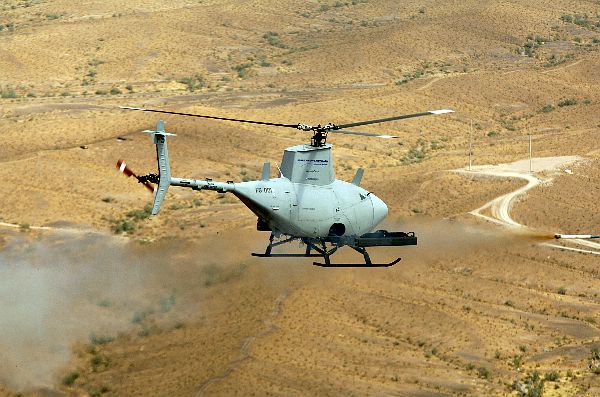
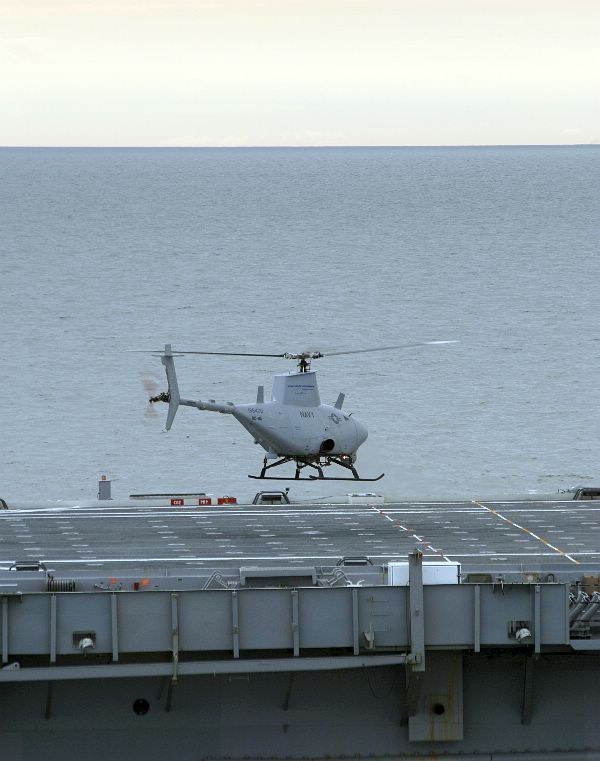
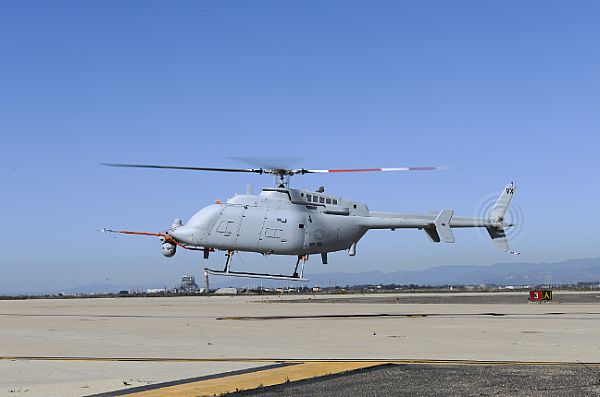

| FY | Block No. | Bu.No. | 機数、備考1 | 備考2 |
| RQ-8A | 166400、166401 | ◎2機 | ◎166400は2008年12月31日除籍。 ◎166401は2008年12月31日除籍 |
|
| RQ-8A | 166414~166416 | ◎3機 | ||
| MQ-8B | 167784~167788 | ◎5機 | ◎167788は2012年4月6日除籍 | |
| MQ-8B | 167790~167792 | ◎3機 | ◎167790(c/n N-7) | |
| MQ-8B | 167986~167988 | ◎3機 | ◎167986(c/n N-10) ◎167987は2012年7月26日除籍 ◎167988は2012年12月13日除籍 |
|
| MQ-8B | 168210~168213 (c/n N-13~N-16) |
◎4機 | ◎168211は2011年6月22日除籍 | |
| MQ-8B | 168441~168454 | ◎14機 | ◎168441(c/n N-17) ◎168442(c/n N-18) ◎168443(c/n N-19) ◎168444(c/n N-20) ◎168445(c/n N-21) ◎168446(c/n N-22) ◎168449(c/n N-25) ◎168450(c/n N-26) ◎168451(c/n N-27) ◎168452(c/n N-28) ◎168453(c/n N-29) ◎168454(c/n N-30) |
|
| MQ-8C | 168455、168456 | ◎2機 プロトタイプ | ◎168456は2014年2月12日に初飛行 | |
| MQ-8C | 168808~168813 | ◎6機 | ◎168808(c/n 53347) | |
| MQ-8C | 168982~168987 | ◎6機 | ||
| MQ-8C | 169037~169039 | ◎3機 | ||
| MQ-8C | 169484~169489 | ◎6機 |
- ボーイング社インシツ部門製 初飛行:2012年7月28日(RQ-21A) RQ-21Aデータ=全幅:4.87m 全長:2.49m 全高:5.004m 翼面積:49.239m² 空虚運用重量:36.74kg 最大離陸重量:61.23kg パワープラント:定格出力8hpのEFIピストン・エンジン1基 最大速度:138.40km/h 実用上昇限度:5,943m 航続時間:16時間 プログラム・コスト:$599,000,000(FY2017までの104システムの推定コスト)
- ※圧縮空気を用いたカタパルトにより発進、スカイフックにより回収するという運用法。システム構成は、UAV×5、地上管制ステーション×2、カタパルト×1、スカイフック×1
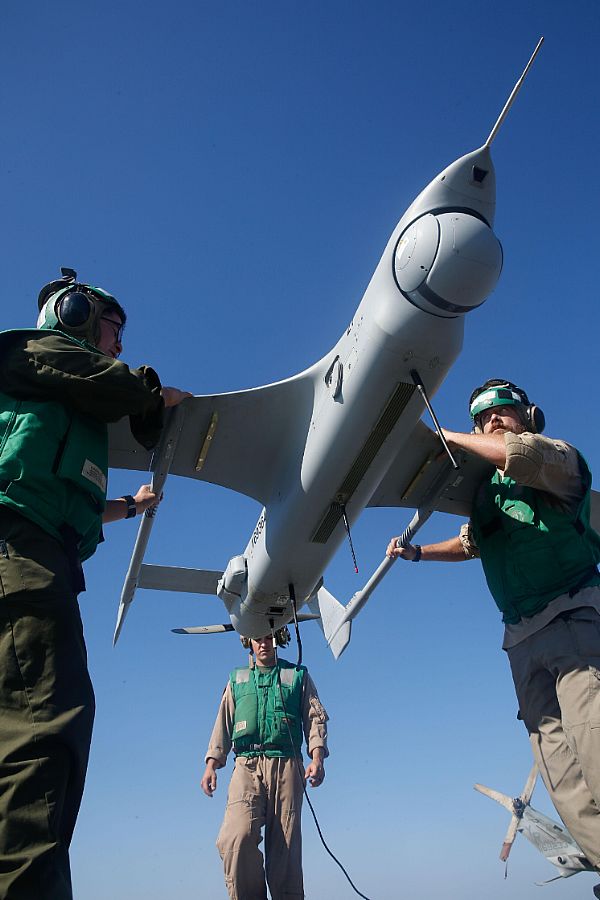
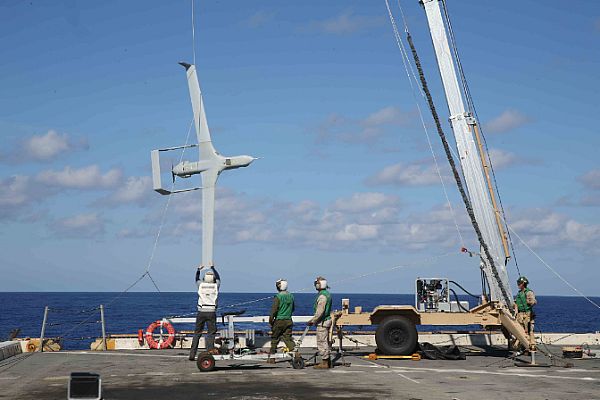
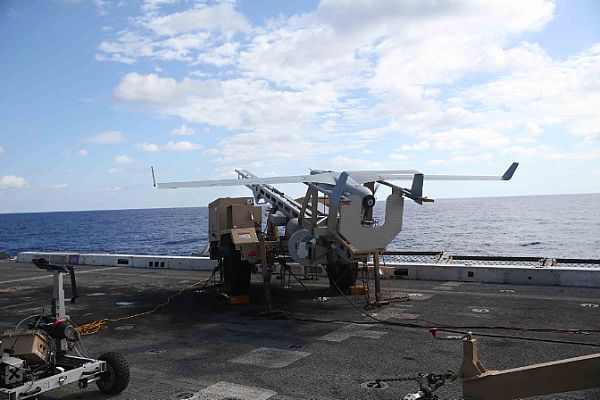
| FY | Block No. | Bu.No. | 機数、備考1 | 備考2 |
| RQ-21A | 168750~168753 | ◎4機 | ||
| RQ-21A | 169040 | ◎1機 | ||
| RQ-21A | 169171~169176 | ◎6機 | ||
| RQ-21A | 169364~169370 | ◎7機 |
Update 25/09/14